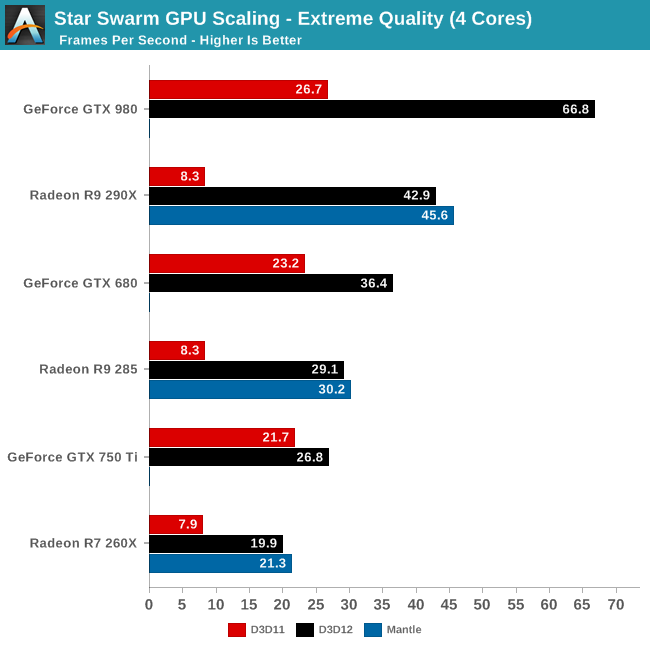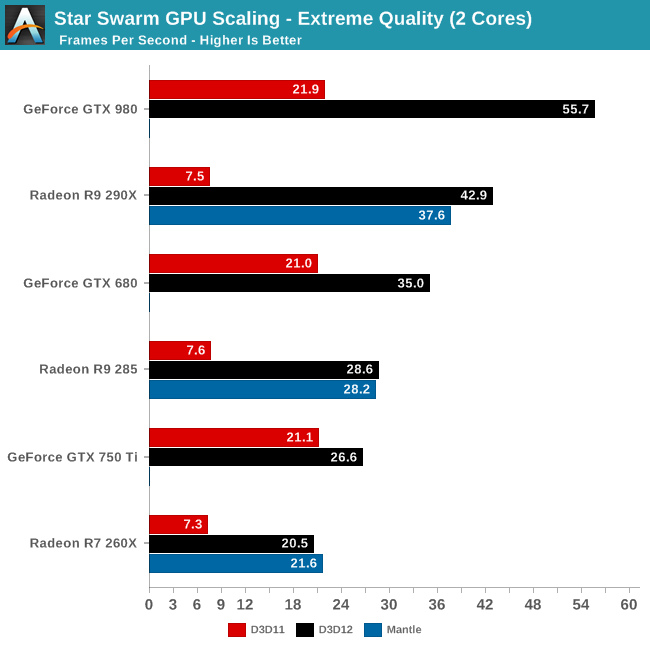The DirectX 12 Performance Preview: AMD, NVIDIA, & Star Swarm
by Ryan Smith on February 6, 2015 2:00 PM EST- Posted in
- GPUs
- AMD
- Microsoft
- NVIDIA
- DirectX 12
GPU Scaling
Switching gears, let’s take a look at performance from a GPU standpoint, including how well Star Swarm performance scales with more powerful GPUs now that we have eliminated the CPU bottleneck. Until now Star Swarm has never been GPU bottlenecked on high-end NVIDIA cards, so this is our first time seeing just how much faster Star Swarm can get until it runs into the limits of the GPU itself.

As it stands, with the CPU bottleneck swapped out for a GPU bottleneck, Star Swarm starts to favor NVIDIA GPUs right now. Even accounting for performance differences, NVIDIA ends up coming out well ahead here, with the GTX 980 beating the R9 290X by over 50%, and the GTX 680 some 25% ahead of the R9 285, both values well ahead of their average lead in real-world games. With virtually every aspect of this test still being under development – OS, drivers, and Star Swarm – we would advise not reading into this too much right now, but it will be interesting to see if this trend holds with the final release of DirectX 12.
Meanwhile it’s interesting to note that largely due to their poor DirectX 11 performance in this benchmark, AMD sees the greatest gains from DirectX 12 on a relative basis and comes close to seeing the greatest gains on an absolute basis as well. The GTX 980’s performance improves by 150% and 40.1fps when switching APIs; the R9 290X improves by 416% and 34.6fps. As for AMD’s Mantle, we’ll get back to that in a bit.

Having already established that even 2 CPU cores is enough to keep Star Swarm fed on anything less than a GTX 980, the results are much the same here for our 2 core configuration. Other than the GTX 980 being CPU limited, the gains from enabling DirectX 12 are consistent with what we saw for the 4 core configuration. Which is to say that even a relatively weak CPU can benefit from DirectX 12, at least when paired with a strong GPU.
However the GTX 750 Ti result in particular also highlights the fact that until a powerful GPU comes into play, the benefits today from DirectX 12 aren’t nearly as great. Though the GTX 750 Ti does improve in performance by 26%, this is far cry from the 150% of the GTX 980, or even the gains for the GTX 680. While AMD is terminally CPU limited here, NVIDIA can get just enough out of DirectX 11 that a 2 core configuration can almost feed the GTX 750 Ti. Consequently in the NVIDIA case, a weak CPU paired with a weak GPU does not currently see the same benefits that we get elsewhere. However as DirectX 12 is meant to be forward looking – to be out before it’s too late – as GPU performance gains continue to outstrip CPU performance gains, the benefits even for low-end configurations will continue to increase.










245 Comments
View All Comments
loguerto - Saturday, February 7, 2015 - link
Microsoft is on the right way, but still, Mantle is the boss!FXi - Saturday, February 7, 2015 - link
I'm sadly more curious as to whether the 6 core chips prove their worth. A lot of rumor guessing seems to think that DX12 might finally show that a 6 core matters, but nothing here shows that. That's a very key issue when it comes to whether to go for a higher end chip or stick with the 4 core cpu's.GMAR - Saturday, February 7, 2015 - link
Excellent article. Thank you!Shahnewaz - Saturday, February 7, 2015 - link
Wait a minute, isn't the GTX 980 a 165W TDP card? Then how is it pulling over 200 watts?eRacer1 - Sunday, February 8, 2015 - link
The GTX 980 isn't pulling over 200W. The numbers shown are system power consumption not video card power consumption. The GTX 980 system power consumption isn't unusually high.Also, the system power consumption numbers are understating the power difference between the GTX 980 and Radeon 290X cards themselves under DX12. The GTX 980 has such a large performance advantage over the 290X in DX12 that the CPU is also using more power in the GTX 980 system to keep up with the video card.
If anything the 290X power consumption is "too low", especially under DX12. To me it looks like the GPU is being underutilized, which seems to be the case based on the low FPS results and power consumption numbers. That could be due to many reasons: poor driver optimization, 290X architectural limitations, benchmark bug or design choice, Windows 10 issue, 290X throttling problem, etc. Hopefully, for AMD's sake, those issues can be worked out before the Windows 10 launch.
Shahnewaz - Sunday, February 8, 2015 - link
That doesn't explain the <20W difference in both systems.And it's not like the CPU usage is also radically different.
Remember, the TDP difference between the GPUs is a massive 165W (290W vs 165W).
eRacer1 - Sunday, February 8, 2015 - link
"That doesn't explain the <20W difference in both systems. And it's not like the CPU usage is also radically different."Looking at the CPU usage graphs in the review the GTX 980 DX12 CPU average across all four cores is about 80% while the 290X average is only about 50%. So the GTX 980 CPU is doing 60% more work. That alone could easily account for 20+W watts of extra power consumption on CPU in the GTX 980 system. The ~60% CPU higher usage in the GTX 980 system makes sense as the frame rate is 56% higher as well. So what looks like a 14W difference is probably more like a 35W difference between the GTX 980 and 290X video cards.
But the 35W difference doesn't tell the whole story because the GTX 980 is also 56% faster while using less power. So the GTX 980 has a MASSIVE efficiency advantage under these benchmark conditions. And it is doing it within a reasonable TDP because by the time you back out all of the non-GPU power consumption (CPU, memory, motherboard, hard drive, fans, etc.) and PSU inefficiency losses from the 271W system power consumption you'd likely find that the GTX 980 is under 200W.
So the question we are left with is why is a 290W TDP 290X system power consumption only 285W under DX12? By the time you subtract the CPU power consumption (which is somewhat less than that of the GTX 980 test due to only being at 50% load instead of 80%), motherboard, memory and other components the 290X is probably using only 200-220W. To me it looks like the 290X is being bottlenecked and as a result isn't using as much power as one would expect. What the source of the bottleneck is, and if it is correctable, remains a mystery.
Shahnewaz - Saturday, February 7, 2015 - link
It looks like AMD GPUs will get some 400%+ performance improvements! Sick!ET - Sunday, February 8, 2015 - link
My main takeaway from the article is that NVIDIA has done a much better job of optimising its DX11 drivers. AMD needs low level badly.bloodypulp - Sunday, February 8, 2015 - link
They already have it: Mantle.